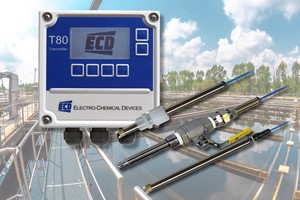Municipal water systems engineers concerned about protecting large surface and tanks water storage systems, will want to consider how the advanced S80-T80 Dissolved Oxygen Analyzer from Electro-Chemical Devices (ECD) helps them easily, accurately and economically measure dissolved oxygen (DO) levels to ensure they protect municipal water supply storage systems as well as protect sensitive ecosystems
Oxygen is naturally present in bodies of water and its levels are measured as dissolved oxygen (DO). These water resources receive their oxygen from the atmosphere and from aquatic plants. Running water, such as that of a swift moving stream, dissolves more oxygen than the still water of a large pond or lake. All aquatic animals such as fish, including those farmed for human consumption, need adequate levels of DO to breathe, feed and thrive.
ECD’s easy-to-use, economical S80-T80 DO Analyzer with its intelligent S80 sensors and intuitive T80 transmitter is the perfect solution for oxygen measurement. This analyzer comes pre-calibrated from the factory, requiring no special tools or installation training. It’s a plug-n-play system that’s ready-to-go out of the box and designed for busy water engineers and techs.
The U.S. Environmental Protection Agency (EPA) warns that low levels of oxygen (hypoxia) or no oxygen levels (anoxia) can occur when excess organic materials, such as large algal blooms, are decomposed by microorganisms. During this decomposition process, DO in the water is consumed. Knowing DO levels allows technicians to remediate issues early on in vital surface water systems with dual use, such as those for both consumption and recreation.
Low oxygen levels often occur in the bottom of the water column and affect organisms that live in the sediments. In some water bodies, DO levels fluctuate periodically, seasonally and even as part of the natural daily ecology of the aquatic resource. As DO levels drop, some sensitive animals might move away, decline in health or even die, contributing to the decline of important natural resource ecosystems.
To prevent these issues, municipal water engineers and industrial technicians often must monitor DO levels—especially in municipal surface water storage systems consisting of reservoirs, lakes, ponds and tanks or enclosure pens for aqua-culture or fish hatcheries. Failure to maintain sufficient oxygen levels also can jeopardize municipal drinking water quality, available supplies and jeopardize sensitive wildlife.
When the intelligent S80’s sensor is connected to the versatile T80 Transmitter, the sensor’s information is uploaded to the analyzer. It then configures the displays and outputs of the transmitter to the values appropriate to the DO sensor’s measurement parameters. The S80-T80 DO Analyzer measures dissolved oxygen levels from 0 to 20 ppm (mg/L) at 250 percent saturation. They operate over a pressure range of 0 to 50 psig and at temperatures (-5 to 80°C).
The standard S80 sensors have 316 Stainless Steel housings although various materials of construction are available to maximize sensor performance while minimizing cost of ownership. They are available in either a choice of insertion or valve retractable configurations for quick disconnect and replacement of sensor cartridges.
The universal T80 Transmitters are available as either single channel or dual channel instruments. This transmitter comes in a 24 VDC or a 100/240 VAC power configuration. All versions are available with the optional HART® output. These line powered instruments have one 4-20 mA output per channel and a MODBUS RTU. Other options include a three-alarm relay package configurable as alarm (set point) relays, timer activated relays or fault relays.














